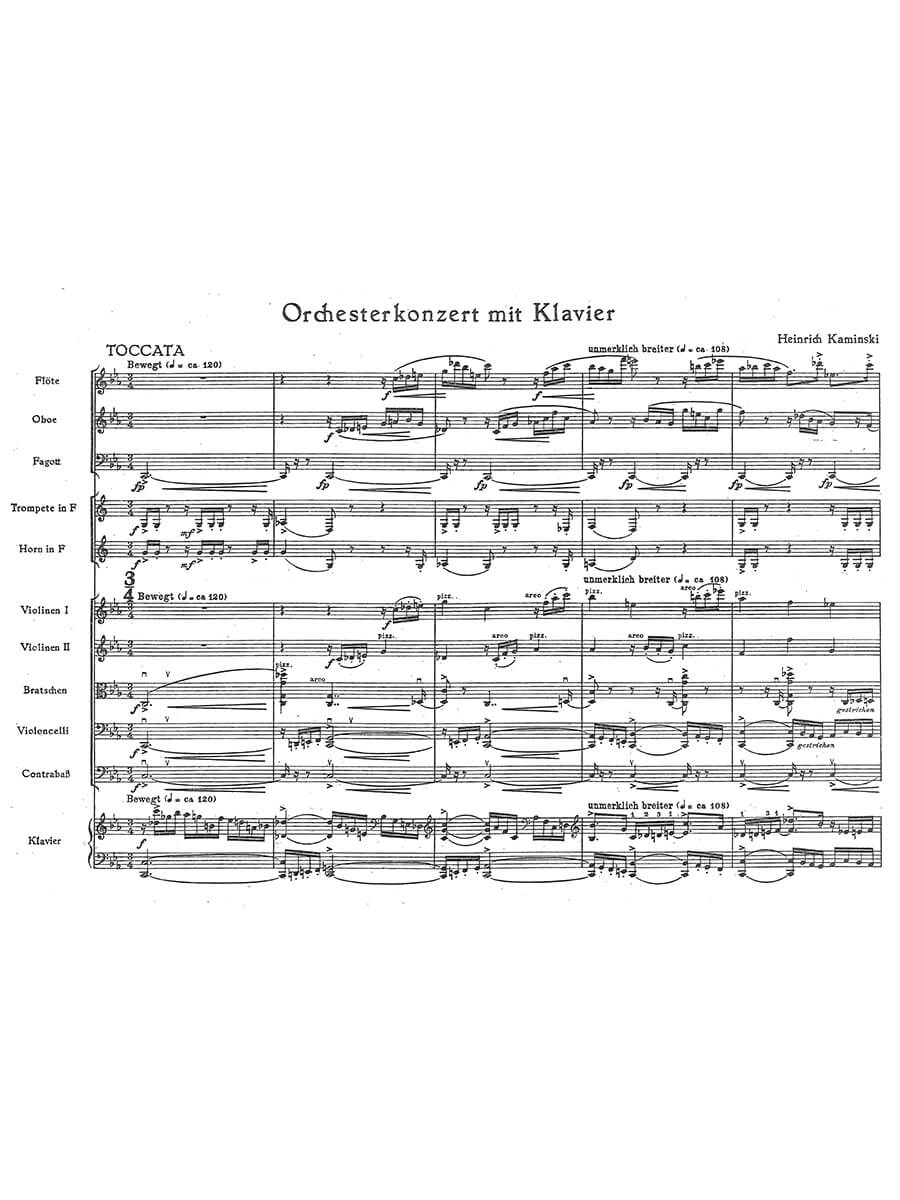Concerto for Orchestra with Piano
Kaminski, Heinrich
26,00 €
Preface
Heinrich Kaminski – Orchesterkonzert mit Klavier
(b. Tiengen, 4 July 1886 – d. Ried near Benediktbeuern 21 June 1946)
(Concerto for Orchestra with Piano, 1935-36)
I Toccata (p. 4)
II Tanz (Dance, p. 38)
III Finale (p. 60)
Preface (Christoph Schlüren, February 2018)
Written in 1935-36, the ’Orchesterkonzert mit Klavier’ (Concerto for Orchestra with Piano) was Heinrich Kaminski’s first orchestral work after the ’Dorische Musik’ (Dorian Music) that had been performed in a most adequate and exhilarating way in Berlin under Wilhelm Furtwängler in 1934. Since its first performances, Heinrich Kaminski‘s ’Dorische Musik’ was considered by most connaisseurs as the most important of his orchestral works. In the permeation of the new instrumental polyphony of a „free community of voices speaking in tongues“, realized in the ’Concerto grosso’ (1923), with the fervent hymnic attitude of his sacred music, it has to be considered perhaps indeed as his most central orchestral work. The development of the »Dorische Musik« stretched, with some interruptions, from the first half of 1932 until February 1934. At the beginning of July 1932, Kaminski wrote to Werner Reinhart: „A different (chamber music) work got in the orchestral work‘s way and keeps me longer than I initially expected.“ This was the ’Musik für zwei Violinen und Cembalo’, which he finished on 15 September. In December 1932, Hermann Scherchen conducted a radio performance of Kaminski‘s opera ’Jürg Jenatsch’ with Heinrich George in Berlin (it was Scherchen‘s last public appearance in Germany before his emigration). The general circumstances of time were not beneficial to quiet work. It came as no surprise that on 1 January 1933, Kaminski‘s part-time lecture-ship at the Berlin Academy of Arts was not renewed. In his own way, Kaminski reacted on 4 July, his 47th birthday, to Hitler‘s seize of power on 30 January and the disastrous development by requesting a small circle of friends in his house in Ried to join an „Order of those who love“, being established herewith, as a sign of internal resistance. The order‘s rules prescribed, among other things, „to hate nothing and nobody, also not to let oneself be tempted to harbour thoughts of hatred, caused by malevolence or maltreatment – for hatred is to be overcome by non-hatred.“ Furthermore, one should „send out loving thoughts into the world at least once a day, and be it only for seconds or minutes“ and, like Buddha, „wake an unlimited soulful feeling towards all beings.“ The membership in the order was not acquired „once and for all times, but again and again through daily renewed devotion to this sevice.“ The rules were to be passed on only to the one „who seemed to be mature for it. Unconditional silence about it is a command that goes without saying.“ (quoted from Hans Hartog, ’Heinrich Kaminski – Leben und Werk’, Tutzing 1987, ISBN 3 7952 05182).
In Bielefeld, where he worked as conductor of the Städtischer Musikverein (Municipal Music Society), and led, among others, celebrated performances of Beethoven‘s Ninths Symphony, Bach‘s Mass in B Minor and Beethoven‘s Missa solemnis, a struggle for power arose between him and the musical director Werner Gößling (1898-1991), who had been installed immediately by the Nazis and who soon got the symphony concerts off him. When in July 1933, Kaminski was warned of impending reprisals due to his all too open statements about the new régime, he went for three months to Präz (Graubünden) in Switzerland, where he now dedicated himself wholly to the new work. Back in Ried, he worked on the completion, with interruptions til January 1934, then in Bielefeld during the phase of rehearsals for the Missa solemnis. The last five pages of the score arrived in Winterthur just three days before the first performance. The premiere of the ’Dorische Musik’ on 27 February 1934 with the Winterthur Municipal Orchestra was conducted by Hermann Scherchen. The loss of the Bielefeld engagement had Kaminski run into financial difficulties, and from June 1934 on until his death his patron Werner Reinhart (1884-1951 from Winterthur payed him a donation of 400 Reichsmark each month. Now he first resumed work on a project he had begun two years previously under the original title ’Klavierbüchlein’ (Little Piano Book) but after some little pieces suitable for beginners he completed as a second volume his ’Tanzsuite’ (Dance Suite) on 24 June 1934, a work that demands a considerable degree of professional pianistic skills. Moreover, he wrote his ’Prelude with Fugue for Viola Alone’ during that period. Then he began to compose a work of confession: the ’Messe deutsch’ (Mass in German) for mixed choir a cappella on an original text that remained unfinished and appeared in print after his death. In May 1935, he completed the ’Klavierbuch’ (Piano Book) that finally comprised three volumes. The third volume (’Prelude and Fugue’ and ’Prelude and Sarabande’) that forms the climax of his piano œuvre..
Read full preface > HERE
Score Data
| Edition | Repertoire Explorer |
|---|---|
| Genre | Keyboard & Orchestra |
| Printing | Reprint |
| Pages | 92 |
| Special Size | 210 x 297 mm landscape format |
